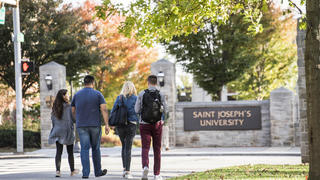STEM Educator Institute Finds a Home on Hawk Hill
The Philadelphia Regional Institute for STEM Education (PRISE), of which Saint Joseph’s is a founding member, is a partnership among colleges in the Philadelphia area and focuses on STEM teacher recruitment, professional development and retention.

KEYS TO THE ARTICLE
- Starting this fall, the Philadelphia Regional Institute for STEM Educators, or PRISE, has made its new home on the Saint Joseph’s campus.
- PRISE is the new name for the Philadelphia Regional Noyce Partnership (PRNP), which emerged from the Noyce program, a scholarship program that aims to recruit and retain science, technology, engineering and math (STEM) teachers in high-needs schools.
- Through a partnership with St. Joe’s and other universities in the Philadelphia region, PRISE will offer larger workshops and events, engage in more widespread networking, and submit more grant applications for STEM teachers.
Starting this fall, the Philadelphia Regional Institute for STEM Educators, or PRISE, has made its new home on the Saint Joseph’s campus. This new institute, with members from multiple colleges and universities in the Philadelphia area, focuses on science, technology, engineering and math (STEM) teacher retention in high-need school districts.
PRISE is the new name for the Philadelphia Regional Noyce Partnership (PRNP), which emerged from the Noyce scholarship program, which aims to recruit and retain STEM teachers in high-needs schools. The Noyce scholarship provides training and mentorship programs, and pays for part of a recipient’s tuition, and for each year of the scholarship the student is required to teach for two years in a high-needs school after graduation. A school is considered high-needs when more than half of the students qualify for a free or reduced-cost lunch.
“PRISE has a vision of making Philadelphia a leader in STEM teacher education and serving as a national model for partnerships in STEM teacher preparation and development,” says Shaily Menon Ph.D., dean of the College of Arts and Sciences. “Housing PRISE at St. Joe’s will enable us to be part of a diversity and equity initiative that strengthens the region’s STEM educational system so as to increase the number of students from underrepresented groups who are prepared to pursue STEM studies in higher education settings.”
Originally, there were six colleges in the Philadelphia area that each separately received the Noyce Grant: St. Joe’s, Temple University, the University of Pennsylvania, Drexel University, La Salle University, and Bryn Mawr College. “I began to wonder how these schools could work together to build connections between our Noyce programs,” says Victor Donnay, Ph.D., a math professor at Bryn Mawr and the founder of PRISE. “I called the other participating schools in the Philadelphia area, and we talked about combining forces.”
In 2011, they formed a partnership that became the Noyce Partnership, and were able to expand the resources provided by the Noyce scholarships. The schools were able to organize larger workshops and events, engage in more widespread networking, and submit more grant applications.
The Noyce Partnership eventually expanded to include other area schools that did not have Noyce grants, such as Arcadia University, the Community College of Philadelphia, and West Chester University. “We wanted to broaden the base of universities that could be part of the partnership,” explains Donnay. “A more vibrant community of fellow teachers can pull together, and make Philadelphia a national destination for STEM teachers.”
Tetyana Berezovski, Ph.D., professor of math and director of SJU’s graduate programs in mathematics education, explains the importance of having resources for STEM educators. “There are uniform programs across the nation and state, because the state has requirements to be certified as a secondary math and science teacher,” Berezovski says. “For example, at St. Joe’s, if you want to become a STEM teacher in four years, you need to double major. You’d have to be a chemistry major and an education major, [for example]. Or you’d have to be a physics major, and an education major. You’d need teaching experience, and experience in labs.”
“This institute will fill in the gaps to better prepare teachers who will stay in the workforce, because within two years, 50% of teachers leave.”
Tetyana Berezovski, Ph.D.
Math ProfessorPRISE fills an important role in allowing students to receive additional training in topics like education for sustainability or culturally relevant teachings. “This institute will fill in the gaps to better prepare teachers who will stay in the workforce, because within two years, 50% of teachers leave,” Berezovski says.
Stacy Olitsky, Ph.D., professor of teacher education, is a member of the planning committee for PRISE, and is also an education researcher. “I track the retention of Noyce teachers in the programs,” she explains. “I followed 12 teachers over four years to see which teachers stayed in their programs, and who left. I did a qualitative research study to see what the conditions were that led to teachers staying or leaving.” One of the findings of her study suggested that having potential professional development sessions that address the internal dialogues teachers have with themselves, based on mentor and student interactions, might be useful in affirming their identities as teachers. PRISE will use Olitsky’s research to create workshops, webinars and courses to better improve teacher retention going forward.
PRISE will differ from the Noyce Partnership in two major ways. One way is that PRISE will expand its focus beyond the Noyce program to be for all teachers, focusing on STEM teaching innovations. Changing the name signifies the institute’s broader focus.
The second change will be that PRISE will make its institutional home on Hawk Hill. The Noyce Partnership did not have a physical location, nor did it have personnel. Its members would take turns meeting at different universities. Having a home at Saint Joseph’s allows PRISE to raise funds and become more self-sufficient. “We wanted to have a site where we could be housed to do more extensive work,” Donnay says. “Part of the plan is to fundraise so we can have an executive director and a full-time administrator.”
Berezovski was integral to having PRISE based at Saint Joseph’s. “I understood what we value as a community at St. Joe’s, and how we serve those who are underprivileged,” she says. “From that, I tried to build a bridge to connect PRISE to Saint Joseph’s.”
“If you’re a prospective college student and a basketball fan, you might want to come to Philly to be part of the same excitement of the Big 5: Villanova, Penn, Temple, Drexel, La Salle, and St. Joe’s,” says Donnay. “In that same sense that Philly has a national identity with basketball, we want to give that same identity around STEM education.”



